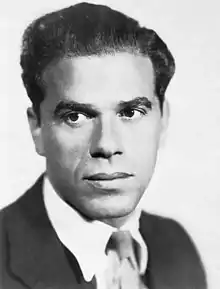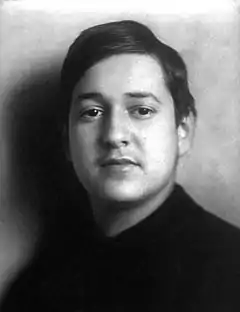11th Academy Awards
The 11th Academy Awards were held on February 23, 1939, at the Biltmore Hotel in Los Angeles, California.[1] It was the first Academy Awards show without any official host. This was also the first ceremony in which a foreign language film (Jean Renoir's Grand Illusion) was nominated for Best Picture.
| 11th Academy Awards | |
|---|---|
| Date | February 23, 1939 |
| Site | Biltmore Hotel |
| Highlights | |
| Best Picture | You Can't Take It with You |
| Most awards | The Adventures of Robin Hood (3) |
| Most nominations | You Can't Take it with You (7) |
Frank Capra became the first person to win three Best Director awards, to be followed by John Ford (who would go on to win four) and William Wyler.
This was the first of only two times in Oscar history that three of the four acting awards were won by repeat winners; only Fay Bainter was a first time award winner. The only other time that this happened was at the 67th Academy Awards in 1994. Fay Bainter also was the first actress in the history of the Oscars to receive two acting nominations in the same year. In addition, Spencer Tracy became the first of only two lead actors to win two years in a row; the other one, Tom Hanks, also did so in 1994. George Bernard Shaw's screenplay win would make him the only person to win both a Nobel Prize and an Academy Award until Bob Dylan received the Academy Award for Best Original Song in 2001 and the Nobel Prize in Literature in 2016.
Radio coverage was banned at the 1939 ceremony. A reporter from KNX, Los Angeles, which had been reporting from the Academy Awards since 1930, locked himself into a booth and was able to broadcast for a few minutes before security guards broke down the door. Partial radio coverage was permitted again at the 1942 ceremony.[2]
Awards
Winners are listed first and highlighted in boldface.
Academy Honorary Awards
- J. Arthur Ball "for his outstanding contributions to the advancement of color in Motion Picture Photography". (Scroll)
- Walt Disney "for creating Snow White and the Seven Dwarfs [1937], recognized as a significant screen innovation which has charmed millions and pioneered a great new entertainment field for the motion picture cartoon". (One statuette and seven miniature statuettes, representing the Seven Dwarfs, on a stepped base.) This is a rare case of a film being recognized in two succeeding ceremonies, as the film was also nominated for Best Score the previous year at the 10th Academy Awards.
- Gordon Jennings, Jan Domela, Dev Jennings, Irmin Roberts, Art Smith, Farciot Edouart, Loyal Griggs, Loren L. Ryder, Harry D. Mills, Louis H. Mesenkop, and Walter Oberst "for outstanding achievement in creating Special Photographic and Sound Effects in the Paramount production, Spawn of the North". (Plaque)
- Oliver Marsh and Allen Davey "for the color cinematography of the Metro-Goldwyn-Mayer production, Sweethearts". (Plaque)
- Harry M. Warner "in recognition of patriotic service in the production of historical short subjects presenting significant episodes in the early struggle of the American people for liberty". (Scroll)
Irving G. Thalberg Memorial Award
Academy Juvenile Awards
Academy Juvenile Awards were presented to:
- Deanna Durbin and Mickey Rooney – "for their significant contribution in bringing to the screen the spirit and personification of youth, and as juvenile players setting a high standard of ability and achievement". (Shared; miniature statuette)
Multiple nominations and awards
|
The following twenty-six films received multiple nominations:
|
The following four films received multiple awards:
|
See also
References
- "The 11th Academy Awards (1939) Nominees and Winners". Oscars.org (Academy of Motion Picture Arts and Sciences). Archived from the original on July 6, 2011. Retrieved 2011-08-10.
- Dunning, John (1998). On the Air: The Encyclopedia of Old-Time Radio (Revised ed.). New York, NY: Oxford University Press. pp. 4–5. ISBN 978-0-19-507678-3. Retrieved 2019-09-10.











